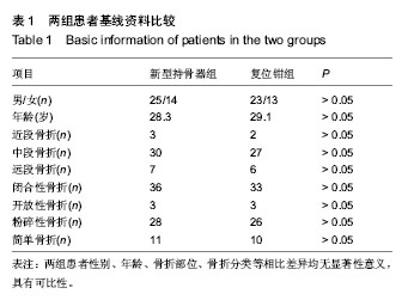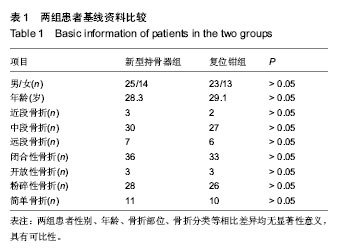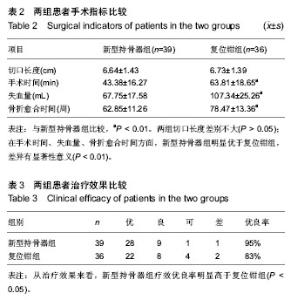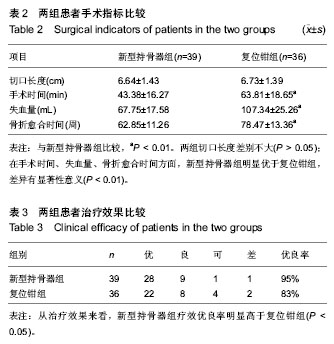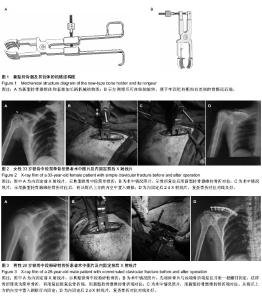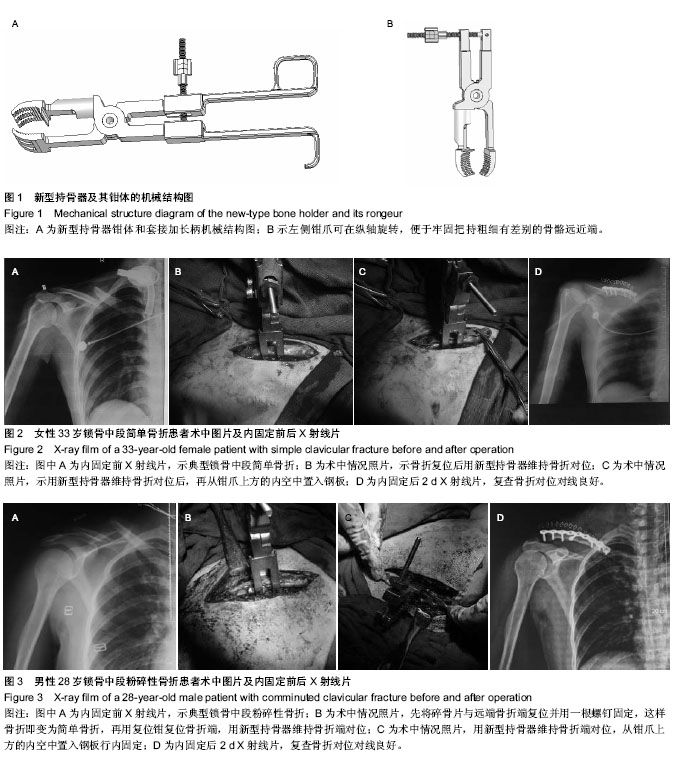| [1] 刘亚波.锁骨骨折的治疗[J].中国骨伤,2012,25(4):267-270.
[2] 曾浪清,陈云丰,刘燕洁,等.锁骨中段骨折治疗现状[J].国际骨科学杂志,2012,33(6):374-375.
[3] 章宁杰,刘万军.锁骨骨折的临床研究现状[J].临床骨科杂志, 2012,15(6):695-698.
[4] 李鼎斌,张昭涛.锁骨骨折的治疗研究[J].中国矫形外科杂志, 2009,17(24):1869-1872.
[5] 周淑平,石承瓒,范伟杰,等.锁骨骨折的治疗进展[J].中外医学研究,2013,11(1):152-154.
[6] 薛燚,王强,顾云峰.双带襻纽扣钢板技术治疗Neer Ⅱ型锁骨远端骨折和Tossy Ⅲ型肩锁关节脱位[J].创伤外科杂志,2010, 12(6):532-534.
[7] 李颖智,金海鸿,左建林,等.解剖钢板或重建钢板内固定治疗锁骨中外1/3交界处粉碎骨折[J].中国骨与关节损伤杂志,2012,27(1): 59-60.
[8] 刘粤,吴亮,张岩,等.锁骨解剖钢板与重建固定带微创治疗锁骨中段骨折的比较[J].中国组织工程研究与临床康复,2011,15(48): 9108-9111.
[9] 彭方成,王贤月,王鹏,等.前置重建钢板治疗锁骨中段骨折[J].临床骨科杂志,2011,14(5):509-510.
[10] 陈可新,刘兴才,赵丽艳,等.锁定加压接骨板治疗锁骨骨折骨不连[J].中国骨与关节损伤杂志,2011,26(3):273-274.
[11] 周强,张涛,姜春乾,等.锁骨骨折术后钢板断裂的原因分析[J].中国矫形外科杂志,2011,19(12):1038-1040.
[12] Mishra PK , Gupta A , Gaur SC . Midshaft ClavicularFracture and Titanium Elastic Intra-medullary Nail.Journal of clinical and diagnostic research. JCDR. 2014; 8(1):129-132.
[13] 李恩琪,袁天祥,马宝通,等.锁骨骨折手术治疗与并发症控制研究进展[J].中国矫形外科杂志,2013,21(20):1350-1352.
[14] 赵燕鹏,张立海,唐佩福,等.锁骨中段复杂骨折重建钢板锁定与非锁定的选择[J].实用骨科杂志,2013,19(8): 698-701.
[15] 刘凤祥,龚伟华,唐坚.多轴锁定接骨板、重建接骨板、重建带治疗锁骨中段骨折[J].中国骨与关节外科,2013,6(6):505-509.
[16] 瞿杭波,沈进稳,童培建,等.重建钢板三维固定治疗锁骨中段不稳定骨折[J].中国骨与关节损伤杂志,2011,26(3):243-244.
[17] 石文俊,石继祥,曹成福,等.重建钢板不同放置方法治疗锁骨中段粉碎性骨折疗效比较[J].临床骨科杂志,2010,13(1):114-115.
[18] 何彦国, 张伟.锁骨骨折不同固定方式疗效分析[J].实用骨科杂志, 2009,15(8):606-608.
[19] Thormodsgard TM, Stone K, Ciraulo DL, et al. An assessment of patient satisfaction with nonoperative management of clavicularfractures using the disabilities of the arm, shoulder and hand outcome measure.J Trauma. 2011; 71(5): 1126- 1129.
[20] Sun JZ, Zheng GH, Zhao KY. Minimally invasive treatment of clavicularfractures with cannulated screw. Orthop Surg. 2014; 6(2):121-127.
[21] 郑超华,宓士军,陶连辉,等.解剖加压钛板结合螺钉单皮质固定治疗锁骨骨折临床体会[J].中国骨与关节损伤杂志,2013,28(5): 43-44.
[22] 海燕,黄长明,王建雄,等.锁骨骨折内固定术后失败原因分析及对策[J].实用骨科杂志,2010,16(3):199-201.
[23] Sebesta P, Hach J, Tlustý St Z. Middle-third clavicle fracture with ipsilateral acromioclavicular dislocation. Acta chirurgiae orthopaedicae et traumatologiae. Cechoslovaca. 2014; 81 (3):238-240.
[24] 陈羽,宋烜,俞思明.双Endobutton钢板结合锁骨钢板治疗锁骨中段骨折合并肩锁关节脱位[J].中国组织工程研究,2013,17(52): 9005-9010.
[25] 倪国骅,明立功,明立山,等.微创纵行切口逆行髓内穿针治疗锁骨骨折[J].中国骨与关节损伤杂志,2010,25(9):817-818.
[26] 蔡文,黄德征.锁定钢板与重建钢板治疗锁骨干骨折[J].中国社区医师,2010,12(23):36.
[27] 黎军.重建钢板内固定术治疗锁骨骨折47例临床观察[J].广西医学,2010,32(8):964-965.
[28] 张逸飞,周业金,何高,等.锁骨骨折内固定术后钢板断裂的原因分析及预防[J].中国骨与关节损伤杂志,2010,25(2):146-148.
[29] 丘靖,刘展亮,李晓彬,等.锁骨骨折不同内固定方式的疗效分析[J].岭南现代临床外科,2009,9(5):376-380.
[30] Ding M, Ni J, Hu J, et al. Rare complication of clavicular hook plate: clavicle fracture at the medial end of the plate. J Should Elbow Surg. 2011; 20(7):e18-20.
[31] Andermahr JF, aymonville C, Rehm KE,et al. Percutaneous plate osteosynthesis for clavicular fractures. Initial description. Der Unfallchirurg. 2008; 111(1):43-45.
[32] 张连平.锁骨骨折保守与手术治疗的临床比较[J].中国医药指南, 2010,8(32):123-124.
[33] 胡永学.锁定钢板与重建钢板治疗锁骨粉碎性骨折的疗效比较[J].齐齐哈尔医学院学报,2010,31(21):3416-3417.
[34] 熊志刚,叶阳春.锁骨钩钢板和锁定钢板治疗NeerⅡ型锁骨骨折[J].中国骨与关节损伤杂志,2012,27(9):837-838.
[35] 张志光,还一平,曹成福,等.国人锁骨中远端三维解剖研究及其内固定置入后的影响[J].中国矫形外科杂志,2011,19(2): 123-126.
[36] 赵广俊.重建钢板治疗锁骨骨折75例[J].临床骨科杂志,2011, 14(3):350.
[37] 郑继会,苑娜, 胡思斌.锁骨钩钢板治疗锁骨远端骨折和肩锁关节脱位[J].创伤外科杂志,2011,13(1):40-42.
[38] 朱小广,丁亮华,姜世涛. Revo软组织带线铆钉治疗锁骨肩峰端骨折20例[J].中国骨与关节损伤杂志,2011,26(1):62-63.
[39] 陈滨,张最,郭刚,等.重建钢板治疗锁骨中段骨折的临床分析[J].中国骨与关节损伤杂志,2009,24(10):899-900.
[40] 石继祥,曹成福,石文俊.前置与上置重建钢板固定锁骨中段骨折生物力学性能比较[J].中国组织工程研究与临床康复,2010, 14(13):2333-2336.
[41] 黎键,汤志刚.不同部位的锁骨骨折手术治疗体会[J].中医正骨, 2010,22(5):46.
[42] 程正亮,杨明林.重建钢板内固定治疗锁骨骨折[J].临床骨科杂志,2010,13(4):405-406.
[43] 汪涛,叶长清,陈国富. 解剖钢板与克氏针内固定治疗锁骨中段骨折的疗效比较[J].中国药物与临床,2011,11(11):1313-1314.
[44] 刘宇军.锁骨钩钢板治疗锁骨远端骨折和肩锁关节脱位发生并发症的原因分析[J].实用医学杂志,2012,28(3):457-458.
[45] 李玉军,周建伟,王一剑.“S”形锁定钢板治疗锁骨中段粉碎骨折的临床疗效[J].实用骨科杂志,2012,18(5):443-445.
[46] 李洪秋,阿良.锁骨远端骨折治疗研究进展[J].中国骨与关节损伤杂志,2010,25(9):863-864. |
